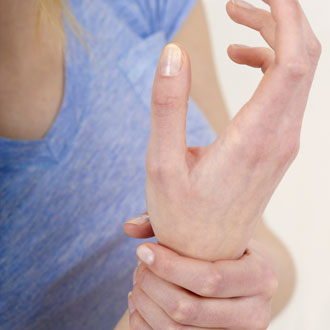The GP overview
This may be the presenting problem but just as often it is a ‘while I’m here’ symptom. The differential diagnosis is quite wide but ‘arthritis’ is often uppermost in the patient’s mind. A brief history and focused examination should provide the correct diagnosis quite rapidly in most cases.
Differential diagnosis
Common
– Osteoarthritis (especially the carpometacarpal joint of the thumb and the distal interphalangeal joints of the fingers)
– Carpal tunnel syndrome
– Trauma (e.g. sprain, scaphoid fracture)
– Rheumatoid (or other inflammatory) arthritis
– Tenosynovitis
Occasional
– Ganglion
– Gout
– Raynaud’s disease or syndrome
– Infection (e.g. paronychia, pulp space)
– Work-related upper limb disorder (WRULD)
– Trigger thumb or finger
– Other nerve entrapment, e.g. ulnar nerve, cervical root pain
– Complex regional pain syndrome
Rare
– Infected eczema (common, but rarely presents with pain)
– Writer’s cramp
– Peripheral neuropathy
– Dupuytren’s contracture (usually painless)
– Diabetic arthropathy
– Osteomyelitis
– Kienböck’s disease (avascular necrosis of the lunate)
Ready reckoner
| OA | Carpal tunnel | Trauma | RA | Tenosynovitis | |
| Symmetrical joint swelling | No | No | No | Yes | No |
| Abrupt onset | Possible | No | Yes | No | Possible |
| Paraesthesiae | No | Yes | No | No | No |
| Worse at night | No | Possible | No | Possible | No |
| Tendon tender | No | No | Possible | No | Yes |
Possible investigations
– LIKELY: none.
– POSSIBLE: X-ray, FBC, ESR/CRP, rheumatoid factor, uric acid.
– SMALL PRINT: blood screen for underlying causes in peripheral neuropathy or Raynaud’s syndrome, if clinically indicated.
– X-ray: may show a fracture in trauma, joint erosions in RA, the typical features of OA, and sclerosis or collapse of the lunate in Kienböck’s disease.
– FBC: Hb may be reduced in inflammatory arthritis; WCC raised in infection.
– ESR/CRP: raised in infective and inflammatory conditions.
– Rheumatoid factor: may support a clinical diagnosis of RA.
– Uric acid: an elevated level (post episode) supports a diagnosis of gout.
Top tips
– OA of the fingers can be relatively abrupt in onset and inflammatory in appearance compared with OA at other sites.
– Explore the patient’s occupation – this will provide valuable information regarding the possible cause and effect of the problem.
– Simply asking the patient to point to the site of the pain can help distinguish two of the most commonly confused differentials: OA of the carpometacarpal joint of the thumb and de Quervain’s tenosynovitis. In the former the pain is relatively localised to the base of the thumb; in the latter the discomfort – and certainly the tenderness – is more diffuse.
– Pain from a ganglion can precede the appearance of the ganglion itself – or the ganglion may be fairly subtle, only appearing on wrist flexion.
– Remember that RA is a clinical diagnosis – don’t rely on blood tests. Early referral minimises the risk of long-term joint damage.
– If in doubt over tenderness in the anatomical snuff box after a fall on the outstretched hand, refer for A&E assessment – a missed scaphoid fracture can cause long-term problems.
– Do not underestimate pulp space infection – this can cause serious complications such as osteomyelitis or bacterial tenosynovitis. It may need IV antibiotics or incision and drainage.
– Thenar wasting suggests significant compression in carpal tunnel syndrome – refer.
Pulse October survey
Take our July 2025 survey to potentially win £1.000 worth of tokens















